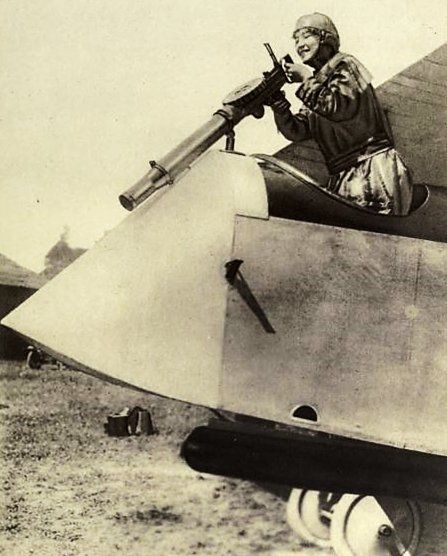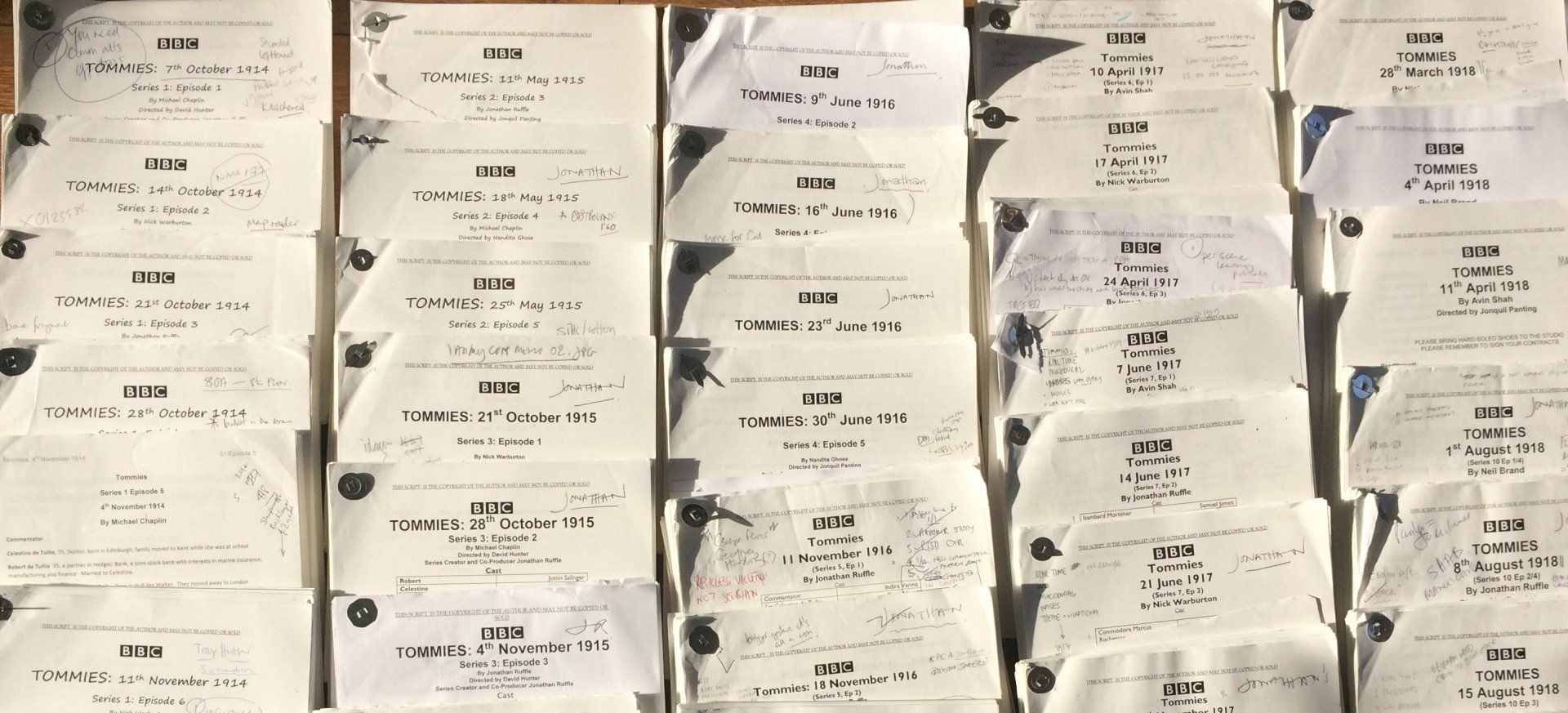The War in Italy
4th April 1918
4th April 1918
4th April 1918
More on this aviatrix in a moment.
I started work on this episode with so many interesting leads - here was the British Army, a newly-fledged RAF, and a war on a tiny bug all happening on the Italian Front, surely one of the most neglected in WW1.
As usual I started reading with as wide a focus as possible to try to get to grips with the subject.
Francis MacKay's 'Asiago' guide in the Battleground Europe series stated me off though it is now very dated. 'Across the Piave' by Norman Gladden was a good trench-level memoir, and MacMillan's 'Offensive Patrol' gave me the basics on the RAF/RFC in Italy.
It was the latter that put me on to the story of the machine-gunning of the Austrian pilot on the ground, and I was immediately reminded of all those conversations from my other life as an airshow commentator where I'd talked about the complex personality of Mick Mannock with my pilot colleague Anna Walker. Here was a pilot doing a very Mannock-like thing - opting to kill a pilot so he wouldn't fly again.
I wasn't going to accuse anyone of doing this unless I could be certain I could stand it up, and I tracked the incident down in the TNA to the 04/05/18 War Diary of 28 Sqn and a pilot named McLeod. I established that 34 Sqn and other elements of 14th Wing flew on the day of transmission - 04/04/18 - and therefore thought it legitimate to elide the two events.
Whereas the 14th Wing war diary – which also had the killing – didn't hush it up at Wing level, which you might expect, there also weren't any refs to anything else like it, though there are strafing attacks on troops on the ground. The Wing diary also had a reference to Tony Benn's dad parachuting agents behind enemy lines. There's a thing.
28 Sqn WD had lots of remarkable colour: Italian memos on codes; reports on duff officers; officers bouncing cheques; officers being banned from using banter (!!); blokes getting VD, busting up the mess, all very interesting. Jones's 'The War in the Air' wasn't very informative but cleared up which squadron was based where and when it moved.
The IWM (complain about them restricting Library access - do it now!) had wonderful RAF & RFC Italian reminiscences. I'd recommend the Private Papers of HS Copestake, Squadron Leader JKA Jeakes, Air Marshal SC Strafford and FG Applebee, who will have to represent here the almost universal desire to firstly mention polenta, the say how much he didn't like it. Bizarre.
I got insights into the Italian take on the war from Mark Thompson's 'The White War' - this was our source for the decimation material, and 'The British Army in Italy' by the Wilk's had the telerifica information. Trench level again was 'The 48th Divisional Signal Company in the Great War' by Dopson.
Francis MacKay's 'Asiago' guide in the Battleground Europe series stated me off though it is now very dated. 'Across the Piave' by Norman Gladden was a good trench-level memoir, and MacMillan's 'Offensive Patrol' gave me the basics on the RAF/RFC in Italy.
It was the latter that put me on to the story of the machine-gunning of the Austrian pilot on the ground, and I was immediately reminded of all those conversations from my other life as an airshow commentator where I'd talked about the complex personality of Mick Mannock with my pilot colleague Anna Walker. Here was a pilot doing a very Mannock-like thing - opting to kill a pilot so he wouldn't fly again.
I wasn't going to accuse anyone of doing this unless I could be certain I could stand it up, and I tracked the incident down in the TNA to the 04/05/18 War Diary of 28 Sqn and a pilot named McLeod. I established that 34 Sqn and other elements of 14th Wing flew on the day of transmission - 04/04/18 - and therefore thought it legitimate to elide the two events.
Whereas the 14th Wing war diary – which also had the killing – didn't hush it up at Wing level, which you might expect, there also weren't any refs to anything else like it, though there are strafing attacks on troops on the ground. The Wing diary also had a reference to Tony Benn's dad parachuting agents behind enemy lines. There's a thing.
28 Sqn WD had lots of remarkable colour: Italian memos on codes; reports on duff officers; officers bouncing cheques; officers being banned from using banter (!!); blokes getting VD, busting up the mess, all very interesting. Jones's 'The War in the Air' wasn't very informative but cleared up which squadron was based where and when it moved.
The IWM (complain about them restricting Library access - do it now!) had wonderful RAF & RFC Italian reminiscences. I'd recommend the Private Papers of HS Copestake, Squadron Leader JKA Jeakes, Air Marshal SC Strafford and FG Applebee, who will have to represent here the almost universal desire to firstly mention polenta, the say how much he didn't like it. Bizarre.
I got insights into the Italian take on the war from Mark Thompson's 'The White War' - this was our source for the decimation material, and 'The British Army in Italy' by the Wilk's had the telerifica information. Trench level again was 'The 48th Divisional Signal Company in the Great War' by Dopson.
The war on trench fever came from 'The Medical War' by Harrison and 'War Surgery' by Scotland and Heys. But the real breakthrough in understanding (sorry lads) was with the essay "Trench fever: the British medical response in the Great War" by RL Atenstaedt, which you can read here.
To broaden the backstories of anyone suffering trench fever I looked at 'The Seventh Division 1914-1918' by CT Atkinson and 'With the 48th Division in Italy' by GH Barnett. But it was 'The 23rd Division, 1914-1919' by HR Sandlilands that had the most amazing fact that try as we might we couldn't get into the play. Because the hillsides were so steep, which hampered the normal trajectories of artillery - get this - they cut lanes for the shells through the trees. Imagine that - shells being deliberately fired so they go within feet of the ridge before going on to the enemy. Amazing.
'An infant in arms: war letters of a company officer, 1914-1918' by GH Greenwell had one of those micro-facts that just underlines you're on the right track - he was reading communiques about the Kaiserschlacht two days after it started, and had London newspapers by 28/04/18. This is good to know for certain when you are trying to gauge how much such events might have penetrated to the level of conversation.
Someone else who knew all about it and put it in her diary was Miss D Field, a VAD, who poignantly had a Nurses Diary with a map of the Western Front where we might find a Tube map, and with Nurses' Tips on each page. They know all about German attack in France on 24th if not earlier.
I also read the private papers of Miss AA Nevill and Miss V Woodroffe who worked in a mobile X-ray unit. Other medical folk included Miss S Reeves, Lady D'Abernon and Captain JH Dible. Owen Morshead was very high echelon, indeed in the end he took the Italian surrender. He is a natural writer, and went on to be Queen's Librarian, and was involved in stealing incriminating documents from a Nazi castle concerning our own Edward VIII. More info in 1996's THE TRAITOR KING, producer Jonathan Ruffle, whatever happened to him?
Also read, but not mined so much, were the private papers of AE Lowy, H Warner, AJ Heraty, VE Cotton, GL Thorley, JC Latter, FJ Marsh, HE Baker – actually this last one was very talkative - he had never seen mountains before. He had an unusual story of hallucinating on a march, tormented by the regularity of the trees, also the extremity of exhaustion.
'An infant in arms: war letters of a company officer, 1914-1918' by GH Greenwell had one of those micro-facts that just underlines you're on the right track - he was reading communiques about the Kaiserschlacht two days after it started, and had London newspapers by 28/04/18. This is good to know for certain when you are trying to gauge how much such events might have penetrated to the level of conversation.
Someone else who knew all about it and put it in her diary was Miss D Field, a VAD, who poignantly had a Nurses Diary with a map of the Western Front where we might find a Tube map, and with Nurses' Tips on each page. They know all about German attack in France on 24th if not earlier.
I also read the private papers of Miss AA Nevill and Miss V Woodroffe who worked in a mobile X-ray unit. Other medical folk included Miss S Reeves, Lady D'Abernon and Captain JH Dible. Owen Morshead was very high echelon, indeed in the end he took the Italian surrender. He is a natural writer, and went on to be Queen's Librarian, and was involved in stealing incriminating documents from a Nazi castle concerning our own Edward VIII. More info in 1996's THE TRAITOR KING, producer Jonathan Ruffle, whatever happened to him?
Also read, but not mined so much, were the private papers of AE Lowy, H Warner, AJ Heraty, VE Cotton, GL Thorley, JC Latter, FJ Marsh, HE Baker – actually this last one was very talkative - he had never seen mountains before. He had an unusual story of hallucinating on a march, tormented by the regularity of the trees, also the extremity of exhaustion.
He was subsequently looked after by contessas (he's a private) and thinks they are 'slappers' at first, don't you just love the Brits? Also doesn't like polenta.
Alice Sherman Hitchcock's picture - the basis for Alice Taylor-Murdock - which is at the head of this piece had been posted on twitter, and thanks to @actonamelie and @Jassicrea as well as @FieldMeasurer for helping me track her down. A woman flying with the Italian air force, good grief, isn't research (and history) the gift that keeps on giving?
There's an article about early motoring pioneers in the US and she's name checked in that as the author herself of several articles including 'The Woman's Viewpoint Of Motoring' in 1904. Edith Wharton, Alice B Toklas and Gertrude Stein also gave background.
Pertab Singh was based on Hardit Malik - much more easy to trace - try our old pal Wikipedia.
Domenico Beltrami 35, Londoner, was based on a fascinating series of emails I exchanged with Robert Hearn of the University of Nottingham.
There's an article about early motoring pioneers in the US and she's name checked in that as the author herself of several articles including 'The Woman's Viewpoint Of Motoring' in 1904. Edith Wharton, Alice B Toklas and Gertrude Stein also gave background.
Pertab Singh was based on Hardit Malik - much more easy to trace - try our old pal Wikipedia.
Domenico Beltrami 35, Londoner, was based on a fascinating series of emails I exchanged with Robert Hearn of the University of Nottingham.
Related Episodes
Related Episodes


